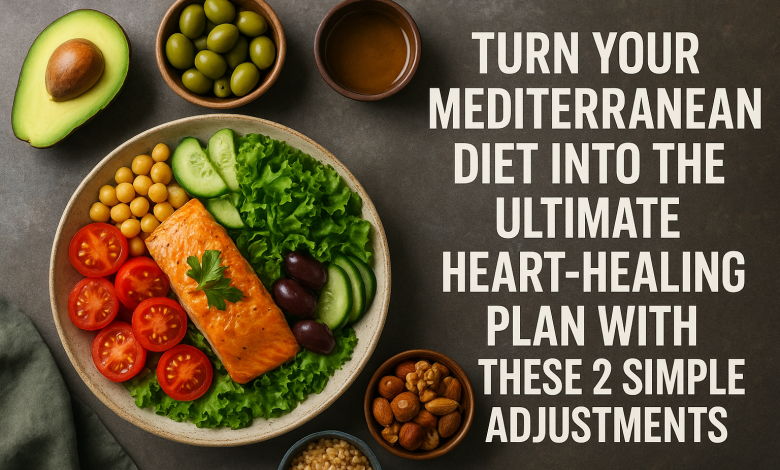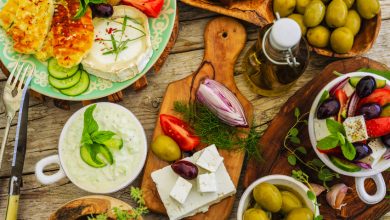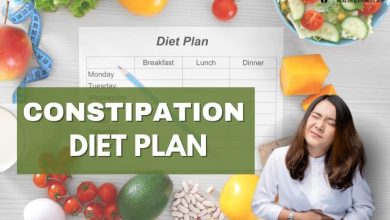Turn Your Mediterranean Diet Into the Ultimate Heart-Healing Plan with These 2 Simple Adjustments

Your heart pumps every moment of your life. It’s the engine that keeps you alive. But did you know that with just a couple of smart tweaks to an already powerful diet (the Mediterranean diet), you can turn it into an ultimate heart‐healing plan? Yes — two focused adjustments can elevate your routine from “pretty healthy” to truly cardioprotective.
Below, I’ll walk you through the emotional “why,” the evidence, and a step-by-step plan so you can adopt these tweaks smoothly — and stay motivated every step of the way.
Why the Heart Deserves More Than a “Good Diet”
Before delving into the how, let’s pause and acknowledge this: your heart feels.
It feels stress, fatigue, worry, joy, and love. It beats faster when you’re excited; it pounds when you’re anxious. In the same way, your body — your heart — seeks nourishment not just physically, but emotionally. You don’t want to “eat well.” You want to heal, to nurture, to protect.
- Imagine your heart as a loyal friend who’s never asked much — just good fuel, rest, and care.
- When you embrace something like the Mediterranean diet, you’re giving it that fuel. But with just two extra refinements, you’re wrapping it in a blanket of protection.
- This isn’t about restriction or deprivation. It’s about empowerment: giving your heart what it truly needs to thrive.
When people hear “diet,” they often think of rules, limitations, and the pressure to be “perfect.” I want you to think of this as an invitation: an invitation to love your heart with intentional small shifts because these shifts can make a huge difference down the road — in your energy, your longevity, your quality of life.
What Is the Mediterranean Diet — and Why It’s Already a Great Base
Before we talk tweaks, let’s honor the backbone you already have. The Mediterranean diet has earned praise from thousands of studies and experts worldwide for its cardiovascular benefits. Its foundation includes:
- Plenty of vegetables, fruits, whole grains, legumes
- Healthy fats (especially olive oil, nuts, seeds, fatty fish)
- Moderate amounts of fish, poultry, and dairy
- Low amounts of red meat and processed foods
- Herbs, spices, and flavoring instead of excessive salt
- Social, mindful eating — shared meals, enjoyment
In broad terms, people following it tend to have lower rates of heart disease, stroke, metabolic syndrome, and inflammation. So you’re already on the right path. The goal is not to undo your diet, but to sharpen and focus it toward heart healing.
The Two Simple Adjustments That Can Transform Your Meal Plan
1. Prioritize Plant-Based Omega-3s + Anti-Inflammatory Oils Over Even Conventional “Healthy Fats”
The Mediterranean diet is famous for olive oil, nuts, and fish. But to become a heart-healing powerhouse, shift your emphasis further toward plant-based omega-3s (ALA) and anti-inflammatory oil blends. Here’s how and why:
- Why this matters:
While olive oil (especially extra virgin) is excellent, it is mostly omega-9 (oleic acid). That’s good. But your heart also needs omega-3 fatty acids — especially EPA and DHA (from fish) and ALA (from plants like flax, chia, walnuts). Omega-3s reduce inflammation, improve endothelial function, lower triglycerides, and help prevent arrhythmias. - How to implement:
- Introduce a tablespoon of flaxseed oil, chia seeds, or ground flaxseed daily into your meals. For example, sprinkle two tablespoons of ground flaxseed on your morning oatmeal or yogurt, or stir chia into your smoothie.
- Use walnuts as a midafternoon snack or toss a handful into your salad.
- Occasionally, rotate in hemp seeds or chia seed oil in dressings.
- If you already eat fatty fish (salmon, sardines, mackerel), keep them — but think of them as bonus heart healers, not the only source of omega-3.
- Create an oil blend: e.g,. 60% extra virgin olive oil + 20% flaxseed oil + 20% walnut oil (or similar), to drizzle over vegetables, salads, or cooked grains.
- Emotional framing:
Tell your heart you love it by giving it those “bonus gifts” — those special plant-based oils and seeds that say, “I went the extra mile for you.” It’s more than doing “okay” — it’s doing thoughtful.
2. Add a Daily “Nitric Oxide & Polyphenol Booster” Habit, Right Before or During a Meal
Nitric oxide (NO) is a molecule your body makes, which dilates blood vessels, lowers blood pressure, and improves circulation. Polyphenols are powerful antioxidants found in many plant foods. Together, they support vascular health, reduce oxidative stress, and help your arteries stay flexible and youthful.
Here’s how to build this second adjustment into your routine:
- Why this matters:
As we age, our nitric oxide production declines. Damaged or stiff arteries cannot taper or expand well, which stresses the heart. Polyphenols help preserve NO, reduce oxidation of LDL (“bad cholesterol”), and calm inflammation. - How to implement:
Choose a “booster” you enjoy and take it daily (or most days) near your main meal. Examples include:- Beetroot (juice or powder): ½ cup of beet juice, or 1 tablespoon of beet powder in water, 30 minutes before your meal or with it.
- Pomegranate juice or extract: 100 ml fresh pomegranate juice or equivalent.
- Dark berries or cherries: A small bowl of blueberries, blackberries, or tart cherries can also help.
- High-polyphenol extra virgin olive oil drizzle: Use the first-pressed oil high in polyphenols.
- Green tea (matcha) or cocoa (dark, unsweetened): A small cup with a meal can boost polyphenols and NO.
- Garlic + onion + herbs: Combine garlic, onion, basil, oregano, etc. — they are natural NO boosters via nitrate/nitrite metabolism.
- Example routine:
- Before lunch or dinner, drink a small glass of beetroot juice (or mix beet powder).
- Then have your meal—rich in vegetables, legumes, whole grains, lean protein, healthy fats. Include a salad with high-polyphenol olive oil, garlic, and herbs.
- Enjoy a small handful of berries or dark cherries as dessert (optionally with plain yogurt or nuts).
- Emotional framing:
This is like giving your blood vessels a “spa treatment” — telling them, “Relax, expand, breathe.” You’re not just feeding; you’re cajoling your arteries into better behavior. You’re sending them a message: “I care about you. You deserve to flow.”
A Heart-Healing Daily Sequence
Here’s a sample daily structure you can adapt to your preferences, time, and schedule. The goal is consistency, not perfection — but if you can stick with this more days than not, you’ll build momentum and resilience.
| Time | What You Do | Emotional/Heart Message | Notes |
| Morning (upon waking) | Glass of water, light movement (e.g., walk, stretching) | “Good morning, heart. I begin with you in mind.” | Helps blood flow start the day |
| Breakfast | Whole grains, fruits, a tablespoon of ground flax or chia, some walnuts, and herbs | “I give you fuel + love” | Use the oil blend in a drizzle or on toast |
| Mid-morning snack (optional) | Fruit, nut mix, or Greek yogurt with seeds | “Steady nourishment” | Keep fiber, healthy fat, and minimal processed sugar |
| Lunch | Large vegetable-and-legume salad or bowl, lean protein (fish or legumes), whole grains, drizzle with oil blend; polyphenol booster before or with meal | “You deserve vibrancy and flexibility.” | Include garlic, herbs, and onions |
| Afternoon snack (optional) | Berries, or cut vegetables + hummus, or walnuts | “Fuel that supports, not depletes” | Keeps energy steady |
| Pre-dinner booster | Beetroot drink, pomegranate juice, or matcha | “Let’s prep your vessels for ease.” | 20–30 min before the main meal or with it |
| Dinner | Similar structure to lunch: lots of vegetables, lean protein, whole grains or pulses, drizzle oil blend, herbs, and spices | “You’re safe, you’re being cared for.” | End with a few berries or a small square of dark (≥ 85%) cocoa |
| Evening/Before bed | Gentle walk or stretching, gratitude reflection (“thank you, heart”) | “You did it — we nourished together” | Let digestion settle before sleeping |
Over time — weeks to months — these two adjustments (plant-based omega-3 + nitric oxide/polyphenol booster) supercharge your Mediterranean base into a heart-healing fortress.
The Science & Evidence Behind These Two Adjustments
Omega-3s & Cardiovascular Health
- Multiple randomized controlled trials and meta-analyses support that EPA and DHA reduce triglycerides, blood pressure, and inflammation, and can reduce the risk of major cardiovascular events.
- Plant-based ALA (from flax, chia, walnuts) can partly convert to EPA (though less efficiently), but also has independent benefits (anti-inflammatory, antiarrhythmic effects).
- When paired with an overall healthy diet like the Mediterranean, the synergy is powerful — better lipid profiles, better endothelial function, and reduced atherosclerotic progression.
Nitric Oxide, Polyphenols & Vascular Function
- Nitric oxide is a key mediator in vascular dilation. Lower NO is associated with hypertension, arterial stiffness, and age-related decline.
- Foods rich in nitrate/nitrite (like beet, leafy greens) provide substrates for NO production in the body, bypassing some age-related enzymatic declines.
- Polyphenols (in berries, pomegranate, dark chocolate, tea, and herbs) reduce oxidative stress, protect LDL from oxidation, and help maintain vascular integrity.
- Clinical studies show that beet juice (even small amounts) improves blood pressure, endothelial function, and exercise performance — all good for the heart.
By combining these two strategies with an already heart-healthy diet, you are layering multiple, complementary mechanisms of protection.
Emotional Motivation & Staying on Track
Changing diet is rarely just rational. You’ll face cravings, busy days, emotional stress, and social temptations. Here are strategies to stay grounded, connected, and emotionally aligned with your heart-healing mission.
1. Anchor to Your “Why”
- Write in a notebook: “Why do I want a stronger, healthier heart?” Maybe it’s for your children, longevity, freedom, energy, or peace of mind.
- Revisit it often. When you feel temptation, pause, breathe, and remind yourself gently.
2. Practice Compassion, Not Perfection
- Missed your beet drink one day? That’s okay. Do better tomorrow.
- Celebrate each small win: you drizzled that special oil blend, you took a walk, you snacked wisely. These are progress.
3. Use Visualization & Gratitude
- After a meal, close your eyes briefly and imagine red, clean, flexible arteries; blood flowing freely; your heart beating strongly.
- Express gratitude to your body: “I’m grateful for my heart’s work. Today I gave you better fuel.”
4. Social & Accountability Support
- Share your heart-healing journey with a friend, partner, or online group.
- Occasionally, cook a Mediterranean-inspired heart-healing meal for others. Turn your plan into connecting rituals, not isolating ones.
5. Track Meaningful, Non-Obsessive Metrics
- Rather than obsess over weight, track energy levels, mood, sleep quality, perhaps blood pressure, or lipid numbers (if you test).
- Celebrate when your resting blood pressure improves, or when simple tasks feel easier.
Sample 7-Day Menu Sketch (with the Adjustments)
Here’s a simplified, flexible sketch to inspire you. Feel free to mix, adapt, or swap based on availability and taste.
Day 1
- Breakfast: Oatmeal with ground flaxseed, walnuts, berries, drizzle oil blend
- Lunch: Lentil and chickpea salad (tomato, cucumber, herbs, garlic), side of grilled salmon, olive oil + walnut oil drizzle
- Dinner: Ratatouille-style veggies with white beans over quinoa, side of steamed greens, herbs, and garlic
- Booster: Beet juice before lunch and dinner
Day 2
- Breakfast: Greek yogurt or plant-yogurt, chia pudding, sliced fruit, nuts
- Lunch: Whole-grain wrap with grilled vegetables, hummus, greens; side salad
- Dinner: Baked mackerel with lemon & herbs, roasted vegetables, farro or barley
- Booster: Pomegranate juice before lunch and dinner
Day 3
- Breakfast: Whole-grain toast, mashed avocado + garlic, side of berries
- Lunch: Mixed bean salad (kidney, garbanzo, black beans), vinaigrette with polyphenol-rich olive oil + herbs
- Dinner: Eggplant, zucchini, peppers, tomato baked dish with herbs, side of whole grains
- Booster: Matcha green tea with lunch
Continue alternating these patterns, with variations in vegetables, beans, fish vs plant protein, and boosters. Always incorporate the oil blend and the booster habit.
Potential Pitfalls, How to Avoid Them, and Adjustments
Pitfall 1: Overdoing Calories or Fats
Even though your oils and nuts are “good,” they are calorie-dense. If weight or blood sugar is a concern, measure portions (e.g., 1–2 tbsp oil, a small handful of nuts).
Pitfall 2: Too Much Sugar in Boosters
Beet or pomegranate juices can sometimes carry sugar. Choose fresh, no added sugar, or dilute with water. Use powder forms if more convenient, and monitor total sugar intake.
Pitfall 3: Boredom or Monotony
Rotate vegetables, herbs, spices, grains (quinoa, barley, farro, millet). Try different boosters. Use seasonal produce. Experiment with Mediterranean-style recipes from different regions (Greece, Southern Italy, Levant, North Africa).
Pitfall 4: Accessibility or Cost
If fresh items are hard to source, freeze berries, use powdered beets or pomegranate extracts, and use canned beans (no salt added). Choose locally available nuts or seeds.
Pitfall 5: Ignoring Medical Conditions or Medication Interactions
If you take blood pressure medications, anticoagulants, or other prescriptions, consult your physician before large increases in certain foods (e.g., beet/nitrate, fish oils). This plan is supportive, but not a substitute for medical care.
What You’ll Likely Notice Over Time
If you remain consistent (say 4–5 days per week) over months, many positive changes may emerge — though individual results vary. Some possible benefits:
- Lower blood pressure
- Better lipid panels (lower triglycerides, better HDL)
- Improved insulin sensitivity / better glucose levels
- Less systemic inflammation (less joint aches, improved energy)
- More flexible, resilient arteries (in higher-level tests)
- Better mood, mental clarity, and emotional stability
- Enhanced stamina on exertion, easier walk, or activity
- A sense of being proactive, self-care, and empowerment
These changes feed into one another: better circulation → more energy → more movement → better mood → better choices → healthier heart.
Final Thoughts & Invitation
By now, you might feel both inspired and a little daunted — “Just two tweaks?” you say. But these are not superficial add-ons; they are purposeful amplifications. Think of them as turning your diet from a “good baseline” to a dedicated strategy for healing, nourishing, and loving your heart.
Your heart doesn’t need you to be perfect. It needs you to be intentional. It needs you to show up with choices, day by day, that say: “You matter. I care.” These two adjustments are a practical embodiment of that message.




